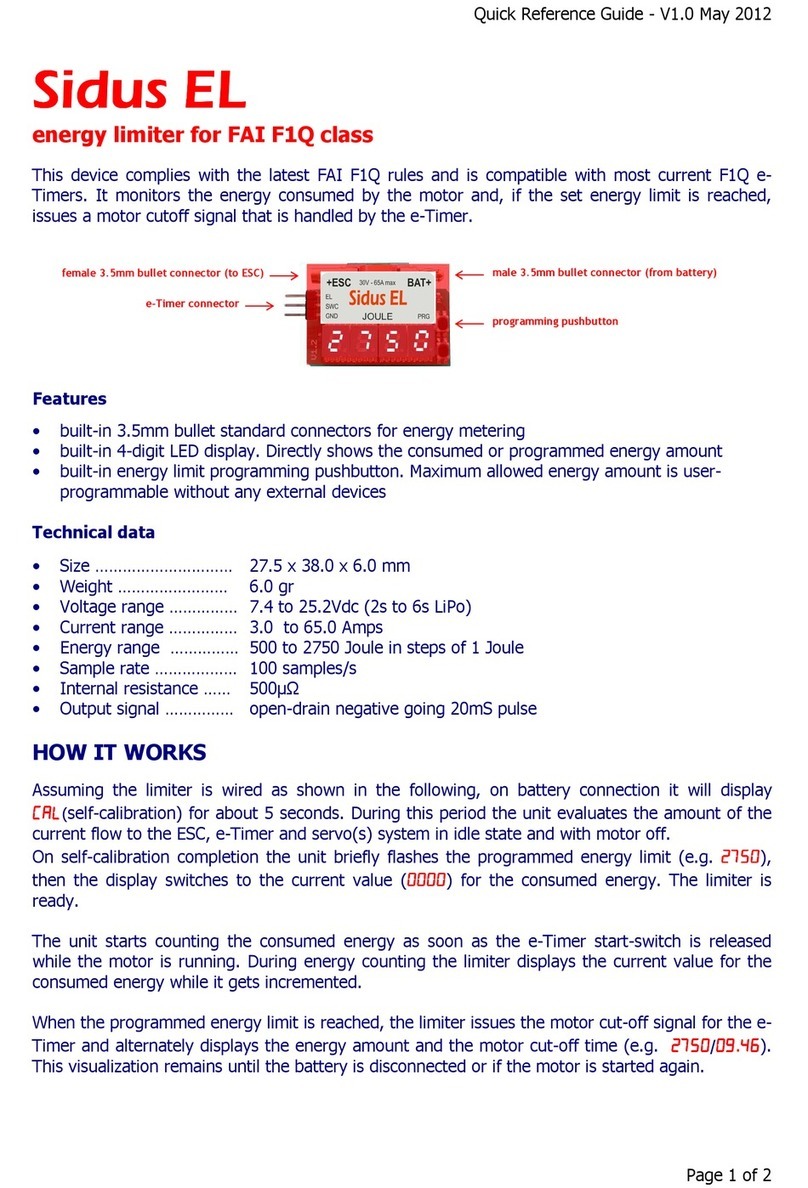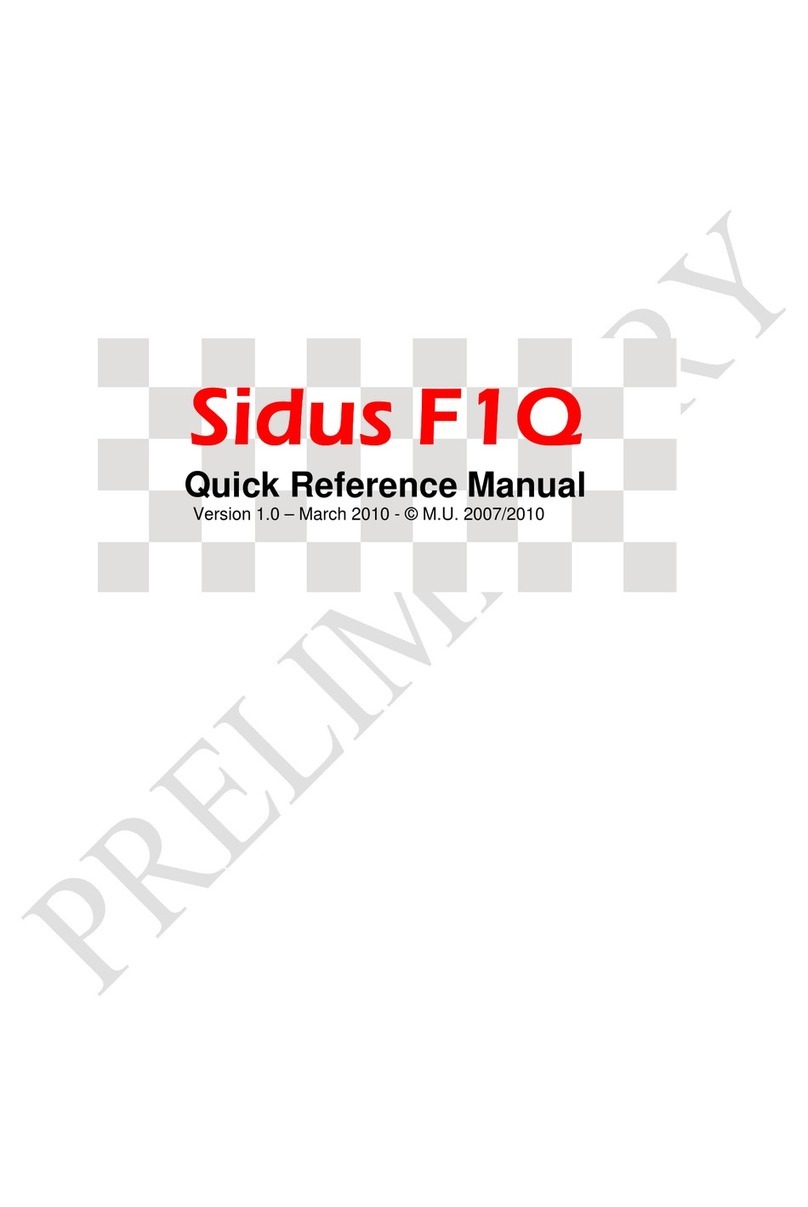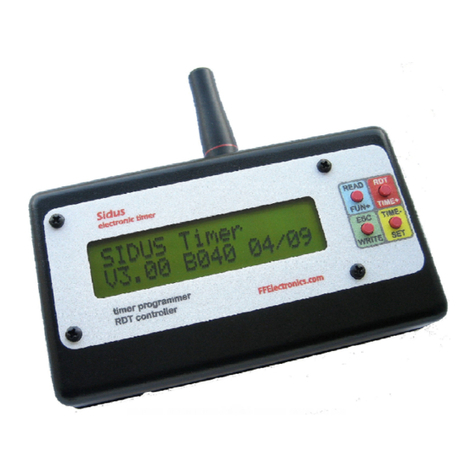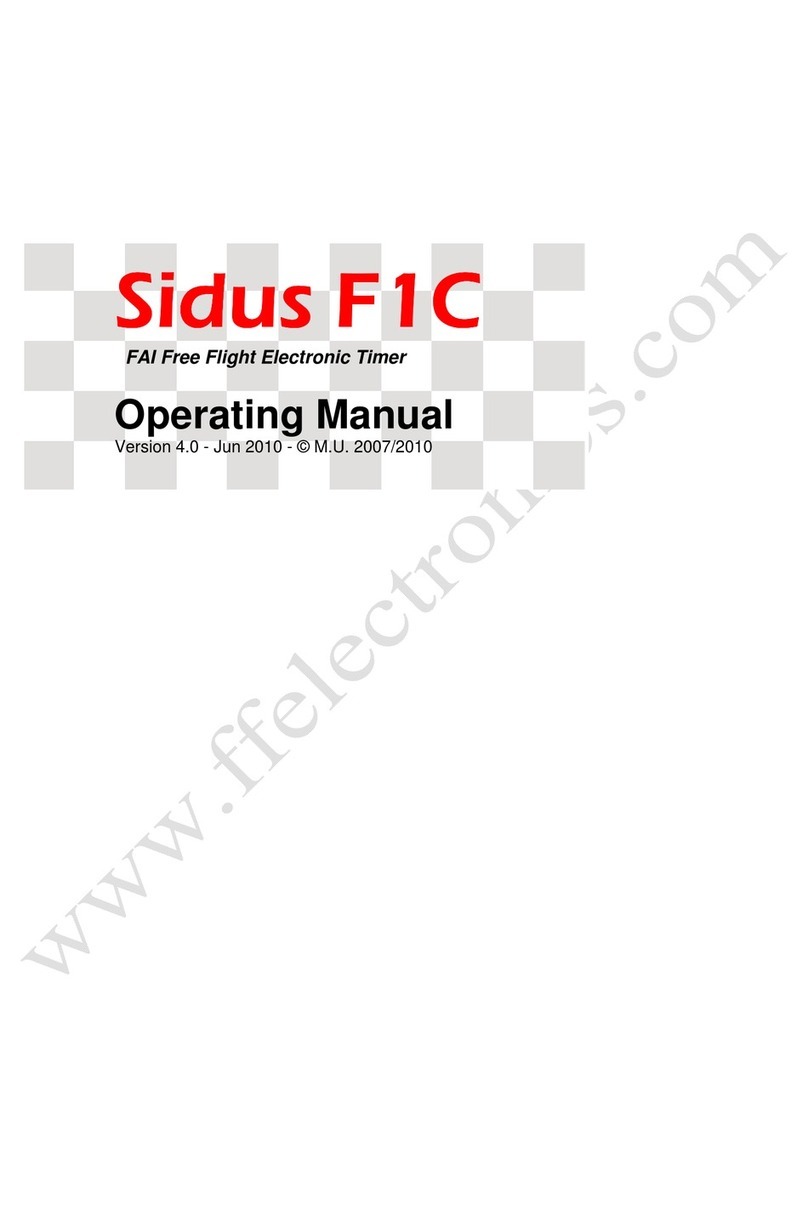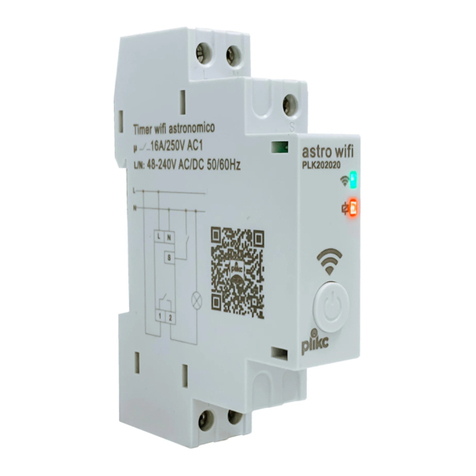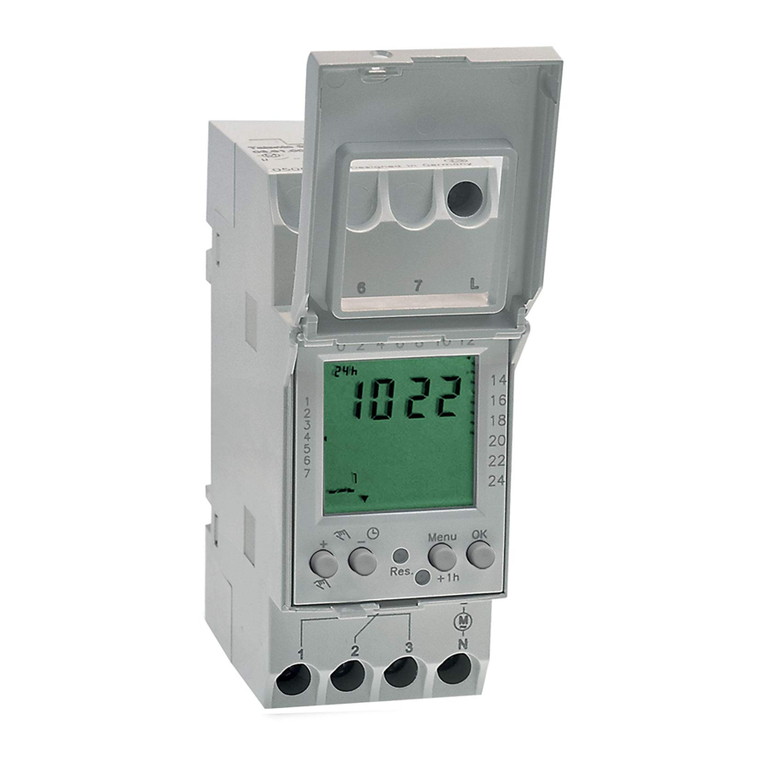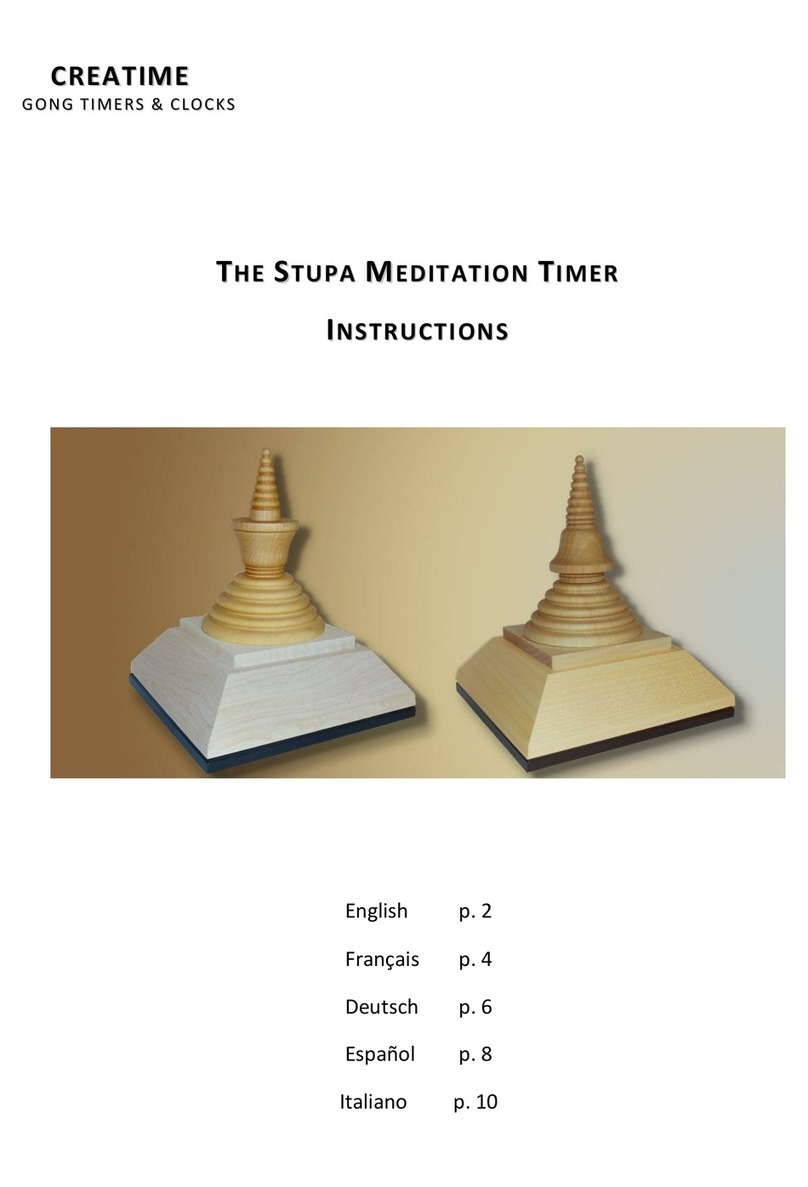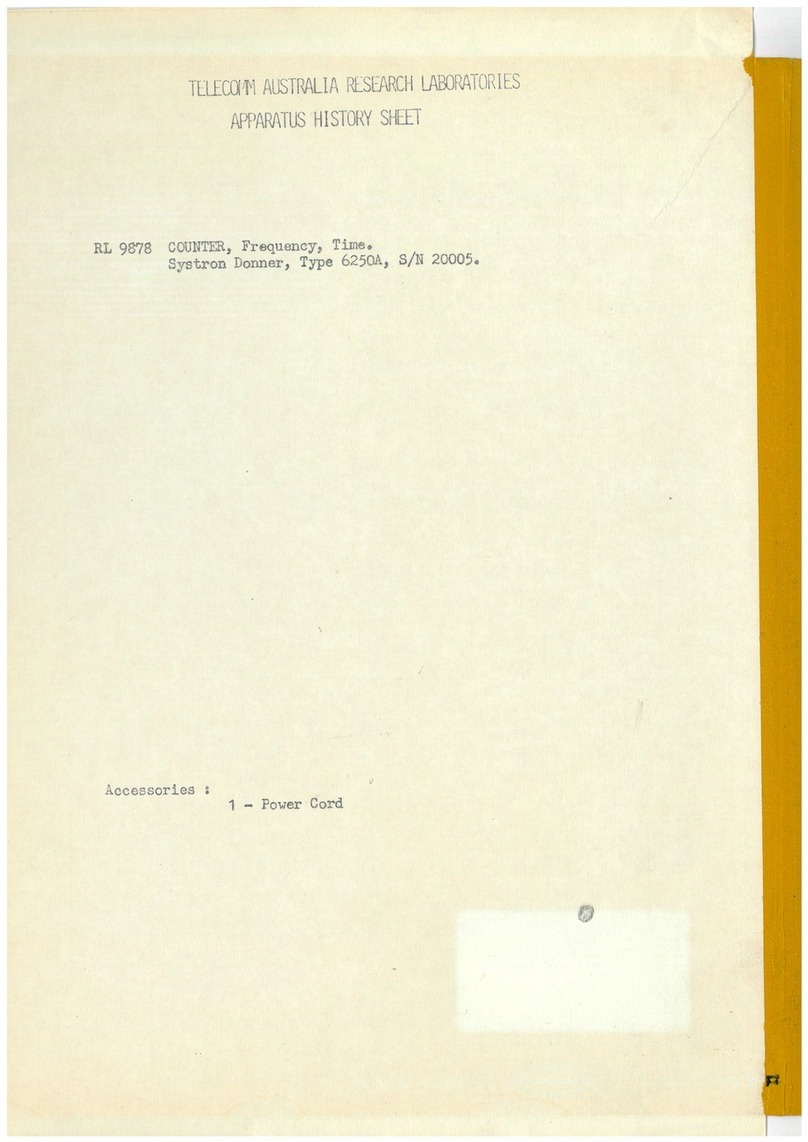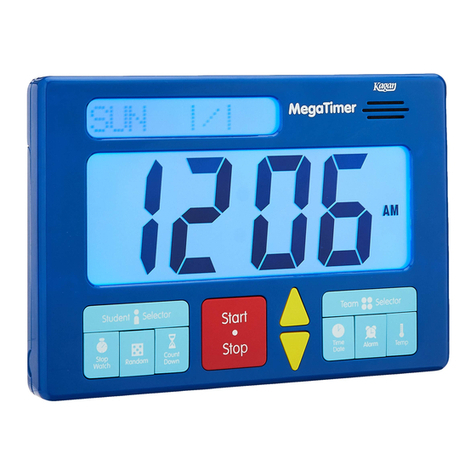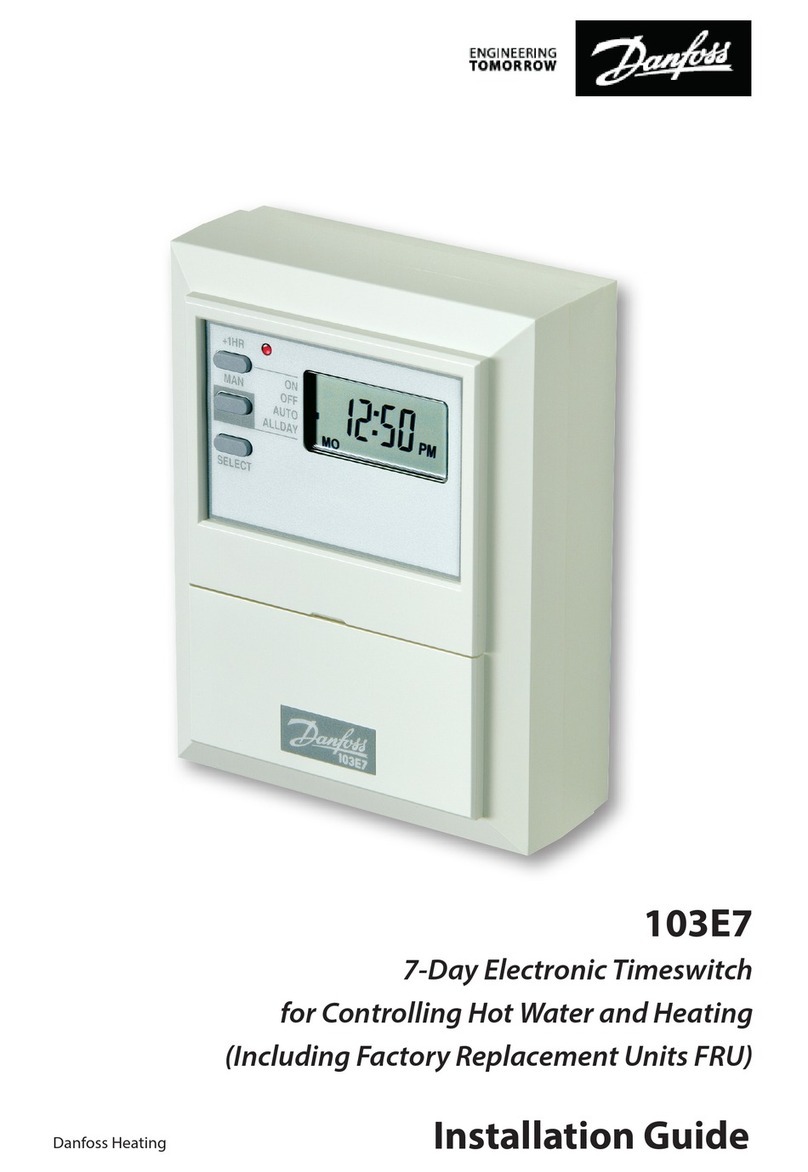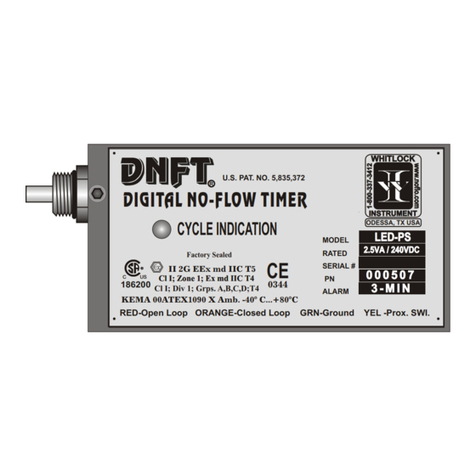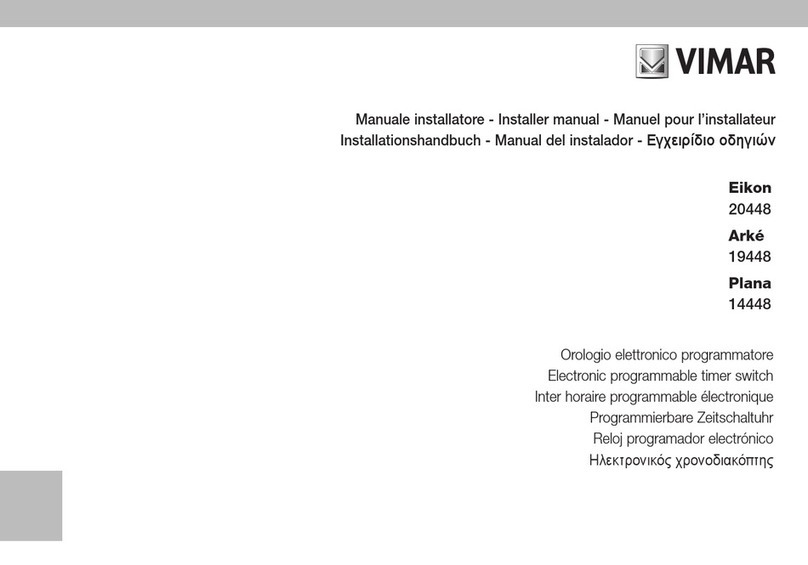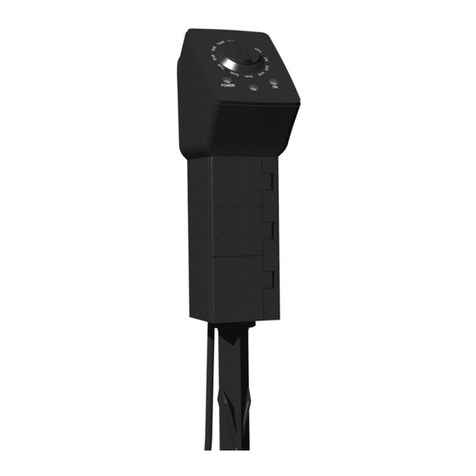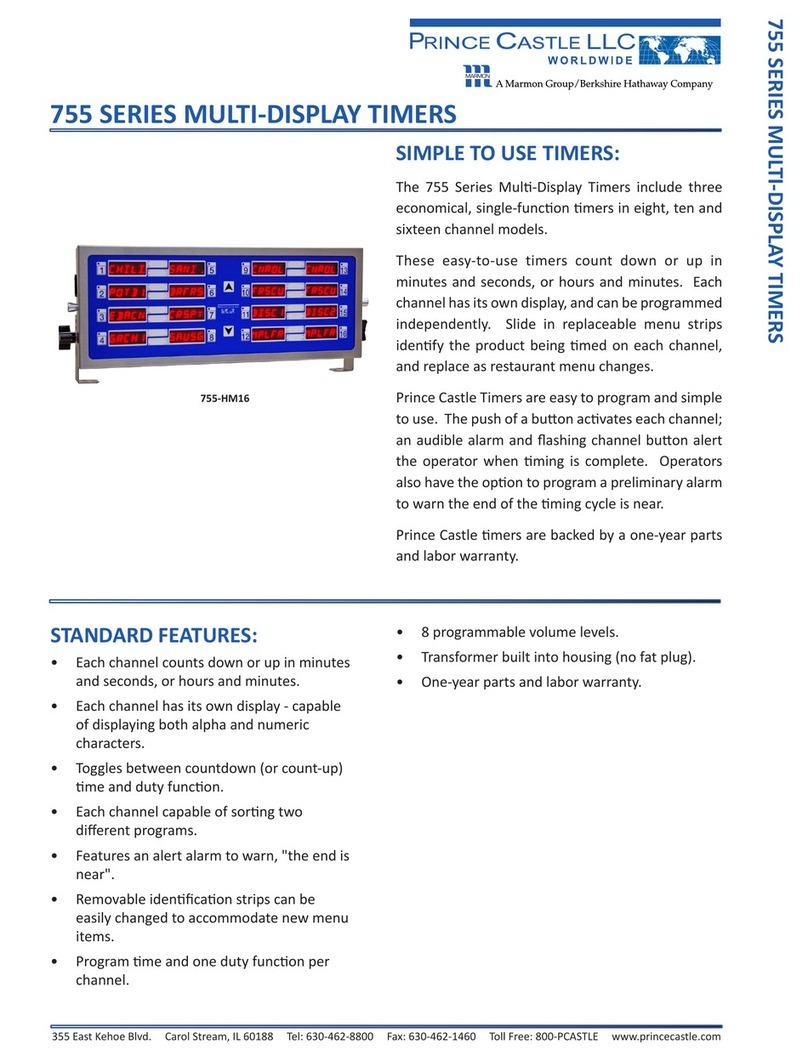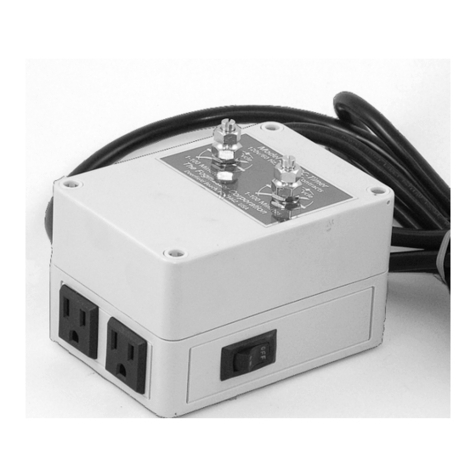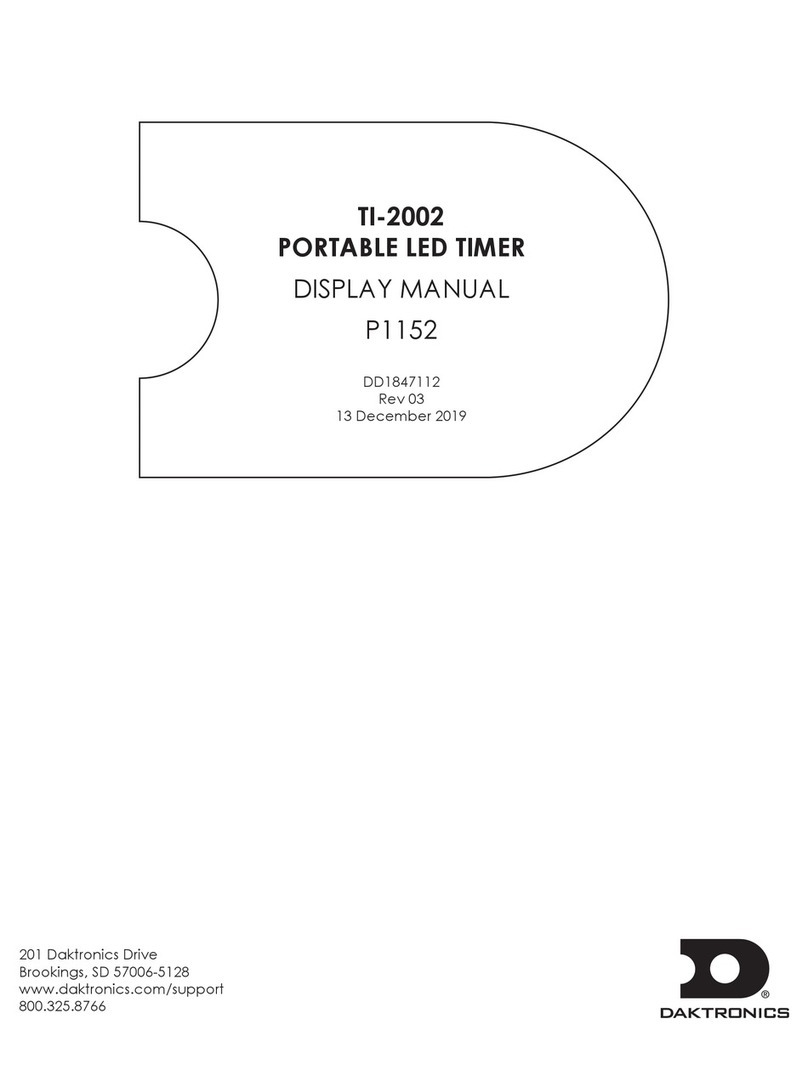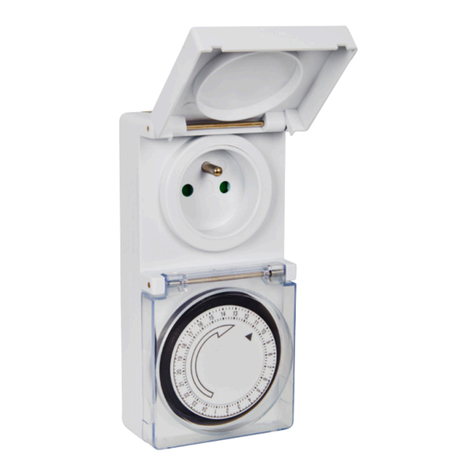ffelectronics Sidus F1Q User manual

Sidus F1
Sidus F1Sidus F1
Sidus F1Q
QQ
Q
Quick Guide
Revision 2.1 – February 2012 - © M.U. 2009/2012
Draft: 3

Sidus F1Q – free flight electronic timer
2/15
The
Sidus F1Q
Sidus F1QSidus F1Q
Sidus F1Q
e-Timer is made up of a control board to be installed on the model
(Timer control board) and a handheld wireless device (Programmer). The Timer controls
the electric motor through a standard ESC (electronic speed controller of type BEC from
which it also draws power) and is capable to drive up to 3 separate servos. It may be used
with a single servo (optional 5-function mechanical assembly releasing traditional arms),
or with 1, 2 or 3 servos that directly move the surfaces. All the Timer functions are
controlled by a single pushbutton. The Timer has on-board buzzer, led lamp, built-in radio
DT and Radio motor cut-off. The Timer has 4 memories to store up to 4 different model
settings.
Getting Started
Refer to the pictures below to locate the system components.
•Locate the connectors, the IR sensor, the red LED, the buzzer and the RDT antenna
socie on the Timer control board
•Connect according to the drawing the Timer control board to the ESC, the
mechanical assembly servo (Servo1) or to the servos (Servo1, Servo2, Servo3), to
the start switch
•Connect the ESC to the battery
•Switch ON the Programmer through the switch accessible after removing the small
slide cover on the back of the device
IR sensor & red led
RDT antenna
socket
P
ROGRAMMER
T
IMER
C
ONTROL
B
OARD
start switch
Bu er
ESC (top)
Servo1 (bottom)
L
I
P
O
C
HARGER
IR sensor
aperture
LCD display
RDT tx antenna
keyboard
9
-
12Vdc
Servo2 (top)
Servo3 (bottom)
+
-
S
+
-
S
3 Servos version
OPTION
RDT antenna
plug

Sidus F1Q – free flight electronic timer
3/15
Timer
Timing duration and resolution
The timing sequence (motor stop and remaining functions) duration is user programmable.
The duration range and resolution depends on the timer class (F1B, F1Q, F1E) that is also
user programmable. The DT function is programmable from 1 to 655 seconds. The motor
function (F1Q only) is programmable from 0.1 to 20 seconds.
Using the Timer
The LED, the buzzer and the disc (or servos) position indicate the current Timer status.
Every time the battery is reconnected to the ESC the Timer gets discharged and
brings the releasing disc (or the servos) to the final position (DT).
Starting from a discharged Timer the sequence is:
ARM THE TIMER:press the start switch to bring the disc (or the servos) to its (their) start
position(s)
LAUNCH THE MODEL:press and hold the start switch. The LED stays ON and the
buzzer beeps 3 times, then the motor is started (F1Q only), then the LED flashes fast and
the buzzer beeps constantly: the model can be launched. The timing sequence will start
as soon as the start switch is released.
(F1Q only) if the start switch is released before the LED flashes, the motor is
stopped and the Timer remains armed and ready to start
TERMINATE THE TIMING SEQUENCE:while the timing sequence is in progress, it can
be terminated by pressing and holding the start switch: the motor stops (F1Q only) and the
disc (or the servos) jump to the DT position
Motor safety start lock (F1Q only): after completing a timing sequence, the motor
is prevented from a new start according to the FAI F1Q class safety rules. The
motor start is re-enabled through the Programmer or by disconnecting and
reconnecting the battery to the ESC
Automatic Timer sleep:the timer automatically “goes to sleep” if inactive for over
2 min. The status of the Timer and all the internal data are retained. The Timer is
awakened by shortly pressing/releasing the start switch.

Sidus F1Q – free flight electronic timer
4/15
Programming the Timer
The Programmer is used to modify the timing sequence and dethermalize the model, and
also allows to calibrate the servo positioning and change other settings.
Each time the Programmer is started, it briefly displays the startup screen
then it switches to the main menu
The possible options are displayed at the corners of the rectangular window of the
display: an option is chosen by pressing the button located at the same corner as
the rectangle made up of the four buttons (see drawing above).
A long (press and hold) or short (press and release) key pressure will be required
to activate the chosen option according to the following rule: choices displayed in
upper case (e.g. READ, UNLOCK,..) require a long pressure, choices displayed in
lower case (e.g. esc, servo,..) require a short pressure
To allow the Programmer to communicate with the Timer, aim the Programmer at
the Timer and keep them closer than 8-10 cm. and the IR sensors mutually visible.
In case of communication failure, the message “ERROR!”is displayed
Timing visualization
For each function the Programmer displays the programmed time and the current
memory:
For convenience, motor stop time and DT time are
displayed absolute, i.e. referred to time zero
All the other functions are displayed relative i.e. the displayed
time represents their duration
The order of the MOTOR stop function is user programmable and it is retained by
the timer once programmed (see following)
READ RDT
UNLOCK SET
FUNC4 t=16.8s ▲
esc m1 ▼
function nr.
MOTOR t=14.9s ▲
esc m1 ▼
DT t=180s ▲
esc m1
current memory nr.
duration time
main menu
timing menu
SIDUS Timer 3S
V5.
5
0 B059 12/
11
sw version
RDT code
release date
mm/yy
startup screen

Sidus F1Q – free flight electronic timer
5/15
Automatic Programmer switch off: the Programmer automatically goes to “sleep” to
save power if inactive for about 2 min. and wakes up by pressing/releasing any key. The
message “Battery low!”indicates that the internal battery needs to be recharged.
Timing sequence modification
Each function has its own activation time and a set of servo(s) positions. The motor is
started at the beginning of the timing and it has a programmable stop time. During timing
the servo positions related to the current function will be kept until the activation of the
following function. Before modifying the timing sequence it must be read from the Timer
1. aim the Programmer at the Timer (make sure it is ON)
2. from the MAIN menu press and hold READ until seeing the screen for the first function
(FUNC1 in the example below)
3. scroll the display with ▲or ▼to view the screens related to the other functions, motor
stop time and DT time. Reach the function which time must be modified
4. press and hold the function number (FUNC4 in the example) until ‘w’ (write) appears
close to the activation time
5. shortly press + or - to increase/decrease the time of one count, or press and hold +
or - to have faster increments/decrements until reaching the wished value
6. shortly press esc once and repeat the previous steps to modify the time of another
function, or shortly press esc again to end the modifications and return to the MAIN
menu
7. if one or more time values have been altered, they must be written onto the Timer for
permanent storing. Press and hold WRITE until the message “Writing…” is
displayed. Should the writing fail, it may be repeated with WRITE or aborted with esc.
To abort the modifications without updating the Timer just make the writing fail by
aiming the Programmer away of the Timer , then choose esc
Motor start unlocking (F1Q only)
After the completion of a timing sequence, re-enable a new motor start by aiming the
Programmer at the Timer (make sure it is ON), then press and hold UNLOCK until the
message “Unlocking…” is displayed.
FUNC1 t=03.5s ▲
esc m1
FUNC4 wt=16.8s +
esc m1 -
FUNC4 t=16.8s ▲
WRITE m1 ▼
FUNC4 t=16.8s
WRITE m1 esc

Sidus F1Q – free flight electronic timer
6/15
SETTINGS
From the MAIN MENU access the list of the available submenus by pressing and holding
SET for over 3 seconds. The list of submenus can be scrolled through ▲or ▼.
Each submenu is accessed by pressing and holding the key corresponding to its name
(e.g. SERVO, MEMORY,…)
READ RDT
UNLOCK SET
MAIN menu
MEMORY ▲
esc ▼
BUZZER ▲
esc ▼
MOTORSTEP ▲
esc ▼
IDLERPM ▲
esc ▼
SERVO submenu
SERVO
esc ▼
MEMORY submenu
BUZZER submenu
MOTORSTEP sub menu
(F1Q only)
IDLERPM sub menu
(F1Q only)
TIMER VERSION submenu
TIMERVER ▲
esc

Sidus F1Q – free flight electronic timer
7/15
Servo 1
position
function
Servo 2
position
Servo 3
position
SERVO submenu – modify the servo positioning
To access this submenu just scroll the settings submenus and press and hold the SERVO
key.
This submenu allows to adjust the position that the servo(s) assume during each function.
When this submenu is entered the servo(s) automatically will move to the start position
(INIT)
1. browse the current servo positions for each available function (INIT, POS1, POS2,….,
DT) with ▲or ▼: the servos will move to the current positions, that will be also
displayed with a value between 000 and 130. Reach the wished position (e.g. POS2 in
the example below)
2. press and release POS2 key multiple times to have an asterisk “*” close to the servo
position to be changed (press POS2 once for Servo1 in the example below)
3. Press and hold POS2 until the asterisk turns to ‘w’ (write)
Press and release +or -to change the servo position: the servo arm will follow with fine
movements accordingly. Holding + or - pressed will produce wider movements. The
new position will be permanently modified with no need to be transmitted to the Timer.
Press and release esc to go up to the SERVO menu to browse other functions and modify
other positions or press esc again to go back to the main menu.
INIT 050 038
esc 110 ▼
POS2 *050 038 ▲
esc 110 ▼
POS2 w050 038 +
esc 110 -
servo submenu

Sidus F1Q – free flight electronic timer
8/15
Current timing memory nr.
MEMORY submenu – Select m1 to m4 memory
To access this submenu just scroll the settings submenus and press and hold the
MEMORY key.
The Timer is capable to store 4 separate complete settings (timing and servo(s)
positioning) named m1 to m4. When this submenu is entered the current memory setting
is displayed.
1. press and release ▲or ▼to choose a new memory number (m1 to m4) or recall a
previously used memory number
2. press esc when finished. If the current memory number has been altered, it will have
to be written onto the Timer for permanent storing
3. Press and hold WRITE until the message “Writing…”is displayed. Should the
writing fail, it may be repeated with WRITE or aborted with esc. To abort the
modifications without updating the Timer just make the writing fail by aiming the
Programmer away of the Timer, then choose esc.
memory = m1 ▲
esc
memory
sub
menu
memory = m3 ▲
WRITE
▼

Sidus F1Q – free flight electronic timer
9/15
BUZZER submenu - enable or disable the built-in Programmer buzzer
To access this submenu just scroll the settings submenus and press and hold the
BUZZER key. When this submenu is entered the current buzzer status is displayed.
1. Press and release ▲or ▼to enable/disable the buzzer. This setting will be
permanently stored until next modification
2. Press and release esc to exit
Buzz = OFF ▲
esc
buzz submenu
Buzz = ON
esc ▼

Sidus F1Q – free flight electronic timer
10/15
Current position of Motor function (1 to 4)
MOTORSTEP submenu – select the order of the motor stop function
To access this submenu just scroll the settings submenus and press and hold the
MOTORSTEP key.
The motor stop function occurs in a fixed order (1
st
to 4
th
function) that can be set here.
For example, if MOTORSTEP is set to 3 the motor stop will be the 3
rd
function, i.e. it will
occur after FUNC2 and before FUNC3.
Note: every time the order of the motor stop function is changed the timing is reset to its
default values.
When this submenu is entered the current motor stop function order is displayed.
4. press and release ▲or ▼to increment/decrement the motor stop order to the wished
value (1 to 4)
5. press esc when finished. If the current motor stop order has been altered, it will have
to be written onto the Timer for permanent storing
6. Press and hold WRITE until the message “Writing…”is displayed. Should the
writing fail, it may be repeated with WRITE or aborted with esc. To abort the
modifications without updating the Timer just make the writing fail by aiming the
Programmer away of the Timer, then choose esc.
motorstep = 3 ▲
esc ▼
motorstep submenu
motorstep = 3 ▲
WRITE ▼

Sidus F1Q – free flight electronic timer
11/15
Current idle rpm value
IDLERPM submenu – select the motor rpm before releasing the model
To access this submenu just scroll the settings submenus and press and hold the
IDLERPM key.
The motor rpm (20% to 100%) after it is started and before the model is released can be
assigned here. This is useful to save energy if the model is held for some time between
starting the motor and launching the model. Whatever the programmed IDLERPM the
motor will instantly take 100% at start switch releasing on model launching.
Note: every time the order of the motor stop function is changed the timing is reset to its
default values.
When this submenu is entered the current idle rpm value is displayed:
1. press and release ▲or ▼to increment/decrement the idle rpm value to the wished
value 20% to 100%)
2. press esc when finished. If the current idle rpm value is changed, it will have to be
written onto the Timer for permanent storing
3. Press and hold WRITE until the message “Writing…”is displayed. Should the
writing fail, it may be repeated with WRITE or aborted with esc. To abort the
modifications without updating the Timer just make the writing fail by aiming the
Programmer away of the Timer, then choose esc.
idlerpm = 30% ▲
esc ▼
idlerpm submenu
idlerpm = 25% ▲
WRITE ▼

Sidus F1Q – free flight electronic timer
12/15
class
fw version
nr. of servos
nr. of functions
nr. of memories
TIMERVER submenu
To access this submenu just scroll the settings submenus and press and hold the
TIMERVER key.
When this submenu is entered the current the lcd will display the following information
about the timer control board:
Press and release esc to exit.
V:Q5.33-3S-10F-4M
esc
timerver submenu

Sidus F1Q – free flight electronic timer
13/15
Radio motor cutoff and radio DT
On the Programmer press and hold T3 (RDT) (> 1 sec) while the timing is in progress to
instantly stop the motor (RMC) and/or dethermalize the model (RDT).
The message “RDT/RMC Transmitting…” will be displayed.
The effect of the command depends on the function that is currently in progress:
•if the motor is ON, the command produces its immediate stop and the Timer “jumps” to
the next function. Pressing and holding again T3 (RDT) the Timer dethermalizes the
model. The programmed DT time remains unchanged
•if the motor is OFF, the command produces immediate model dethermalization
Recharging the Programmer battery
Use only the original LiPo charger. Connect the RED/BLACK cable to a 9-12Vdc power
source (e.g. to the car cigar lighter through a proper adapter). Full battery charge will take
about 2 hours.
Discard the LiPo battery if it has bulges or scratches. The charge must take place
in a safe place, far from flammable materials
RECHARGE: connect the 3-pin charger connector to the 3-pin
Programmer socket accessible after removing the slide cover on the
bottom of its case. The internal battery must remain connected.
WARNING: all the 3 charger pins must be inserted in the socket.
By inserting only 2 pins the charger will get damaged
Status of the charger leds
•9-12Vdc power connected, battery not connected →Green ON, Red ON
•Charge in progress →Red ON, Green OFF
•Charge complete →Red OFF, Green ON
Recommendations
Control board
lay the control board in the fuselage with the optics (IR sensor and led) close to a
side wall, so that they are visible from outside through a small transparent window.
Do not expose under direct sunlight.
Programmer and LiPo Battery
The Programmer battery ensures about 200 DT activations and power for
programming activities of months. If the system is not going to be used for long
3-pin recharge socket

Sidus F1Q – free flight electronic timer
14/15
time, switch the Programmer OFF through the internal switch.
RDT Antenna
The RDT antenna (plastic covered twisted or plain steel wire about 175 mm. long) must
run vertical out of the fuselage and be electrically isolated from carbon. Solder the
antenna to the plug that will be inserted in the socket along the edge of the control board
(see picture at pag. 2). Failure to follow the above will decrease the maximum range of the
whole RDT system.
Installing the Timer on multiple models
One additional Timer control board (plus LiPo and mechanical gear) with the same RDT
code is required to provide another model with the
Sidus
SidusSidus
Sidus
electronic timer. The RDT code
is unique for each modeller to allow all his Timer control boards to be used with a single
Programmer. In addition it makes it possible to use the
Sidus
SidusSidus
Sidus
system simultaneously with
other modellers having the same or other systems.

Wirings
Observe polarities for the
SERVO and ESC plugs!!!
the START SWITCH plug has
no polarity and an be reversed
Other manuals for Sidus F1Q
2
Table of contents
Other ffelectronics Timer manuals
